Power chords are a foundational element for guitarists across genres, especially in rock, metal, and punk. These versatile chords are known for their raw energy and straightforward playability, making them a favorite for beginners and seasoned musicians alike. This guide will delve into everything you need to know about Power Chords On Guitar, from understanding their construction to mastering techniques and applying them to popular songs. Get ready to unlock a powerful sound with just a few fingers!
What Exactly Are Power Chords?
The term “power chord” itself hints at the sonic impact these chords deliver. They are characterized by a strong, direct sound achieved with a minimal number of notes. While you can use power chords on any type of guitar and across various musical styles, they truly shine in genres that demand a powerful and driving rhythm. Though often associated with electric guitar and heavier music, understanding power chords is a valuable skill for any guitarist.
Power chords are built using only two distinct notes, but guitarists commonly play them across three strings. These notes are the root note, the fifth interval, and the octave of the root note. The root note is the fundamental pitch and gives the power chord its name. Therefore, to form a power chord, you play the root, the fifth, and the root again, an octave higher.
Let’s illustrate this with a C power chord. The notes involved are C, G, and C (the second C being an octave higher than the first).
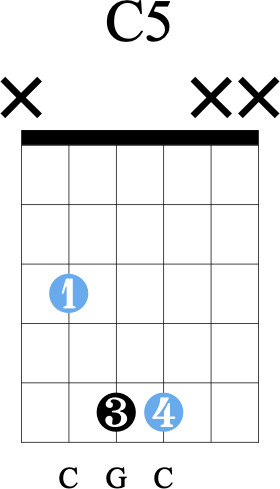 C5 power chord
C5 power chord
Power Chords Compared to Major and Minor Chords
A key distinction of power chords is that they are neither major nor minor. This is because they lack the third interval, which is crucial in defining major and minor chords. For instance, a C major chord consists of the notes C, E, and G.
 C major chord on guitar
C major chord on guitar
In power chords, the emphasis is on the interval between the root and the fifth. The repetition of the root note at the octave adds to the chord’s powerful sound and simplifies its harmonic function.
How to Notate Power Chords
Notating power chords is straightforward. You simply use the root note name followed by the number “5”. For example, a C power chord is written as C5. The “5” indicates the fifth interval added to the root.
It’s important to dispel the myth that playing power chords is somehow “cheating” or inferior. They are a legitimate and widely used chord type, serving as a solid foundation for learning more complex barre chords, both major and minor, on the guitar. Software like Guitar Pro even offers features like a Chord Library to easily incorporate power chords into your compositions.
Exploring Power Chord Shapes
Power chords are wonderfully practical because they utilize a movable shape. This means you learn one basic shape and can slide it up and down the guitar neck to play different power chords.
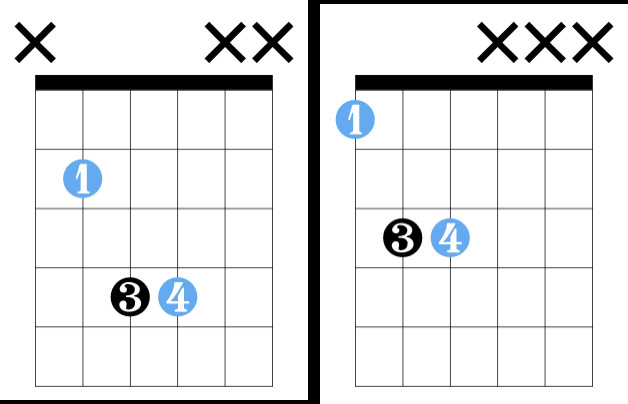 Power chord positions
Power chord positions
This shape is typically played on the lowest three strings (E, A, and D) or the A, D, and G strings. In chord diagrams, an “X” often indicates strings that should not be played or sounded.
You can play this power chord shape using either two or three fingers. The two-finger method requires barring across two strings with your index finger and using your ring finger for the higher octave note. The three-finger method assigns a finger to each of the three notes.
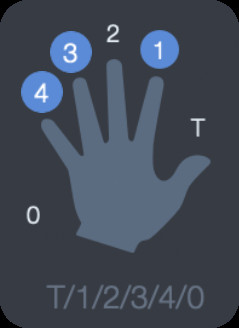 power chord fingering
power chord fingering
Let’s look at the F5 power chord as an example.
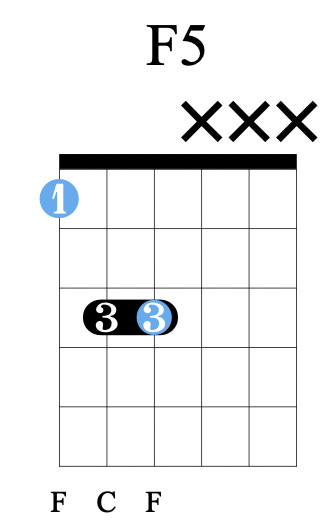 how to play F5 chord
how to play F5 chord
 How to play the F5 power chord on guitar
How to play the F5 power chord on guitar
To effectively utilize these movable shapes, it’s highly beneficial to learn the notes on your guitar neck, especially on the low E and A strings. This knowledge allows you to quickly identify the root note position and play any power chord. Knowing the notes on these two strings essentially unlocks access to at least 24 different power chords.
Remember that the frets without numbers on guitar diagrams represent sharps and flats. For instance, the 2nd fret on the low E string is F# (or Gb), so playing a power chord shape there will give you an F#5 or Gb5 power chord.
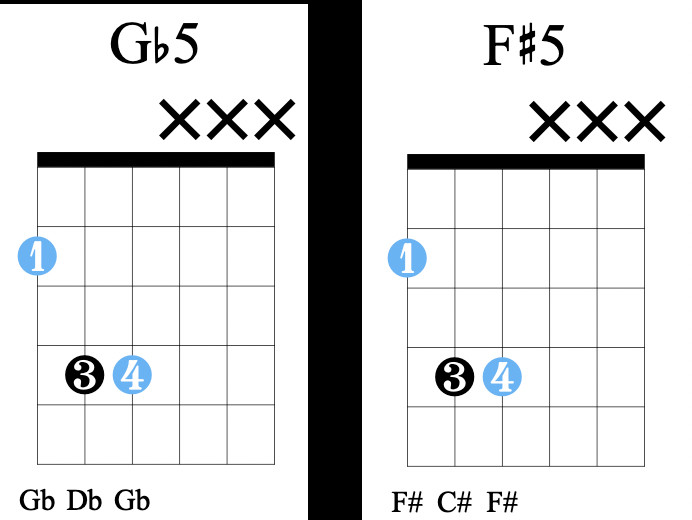 F#5 chord
F#5 chord
 F#5 guitar chord position
F#5 guitar chord position
Power Chord Keys with Root Notes on the Low E String
Here’s a breakdown of common power chords with their root notes located on the low E string:
E5 Chord
The notes in an E5 power chord are E, B, and E. This is often considered one of the easiest power chords to begin with. You can play it with just one finger on the 2nd fret of the E string, ensuring you only strum the top three strings.
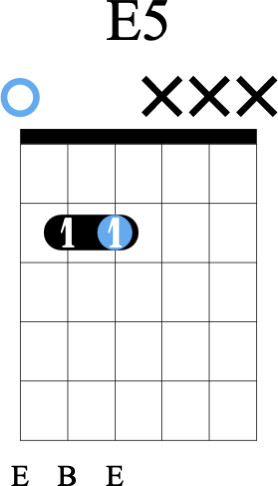 E5 power chord
E5 power chord
F5 Chord
The F5 power chord comprises the notes F, C, and F. It’s a useful alternative to a full F major chord, especially for beginners who find the F major barre chord challenging. Located closer to the guitar’s headstock, F5 can initially feel a bit more difficult to fret cleanly. Interestingly, F5 is the opening chord of the iconic song “Smells Like Teen Spirit”—a great reason to master it!
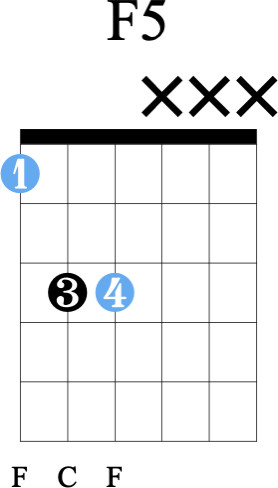 F5 guitar chord with fingering
F5 guitar chord with fingering
G5 Chord
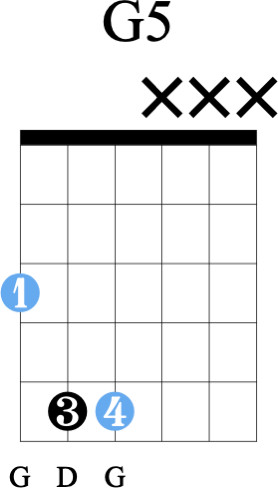 G5 power chordG5 power chord includes the notes G, D, and G.
G5 power chordG5 power chord includes the notes G, D, and G.
A5 Chord
The notes in an A5 power chord are A, E, and A.
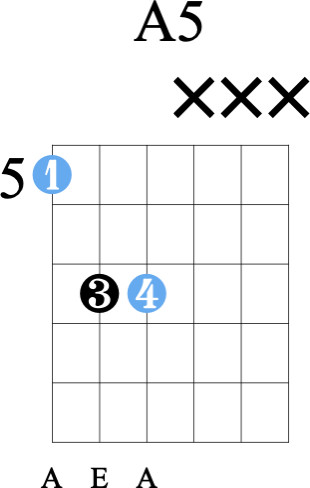 A5 guitar diagram
A5 guitar diagram
B5 Chord
B5 power chord notes are B, F#, and B.
C5 Chord
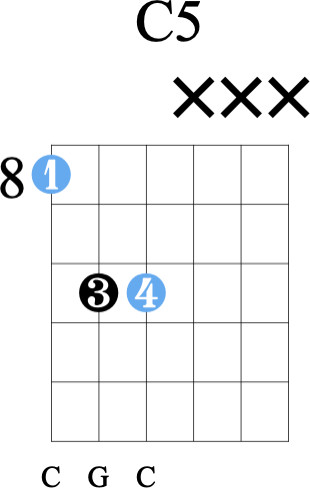 C5 power chordC5 power chord consists of the notes C, G, and C.
C5 power chordC5 power chord consists of the notes C, G, and C.
D5 Chord
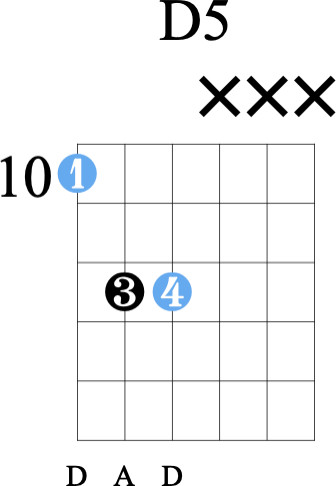 D5 power chordD5 power chord notes are D, A, and D.
D5 power chordD5 power chord notes are D, A, and D.
E5 Chord (Again)
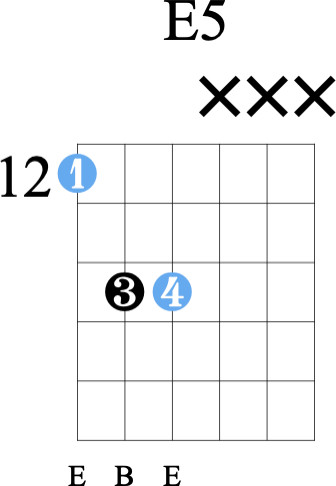 E5 power chord guitarYes, another E5! The notes are again E, B, and E.
E5 power chord guitarYes, another E5! The notes are again E, B, and E.
Here’s a comprehensive list of power chords with root notes on the low E string:
(Consider adding a table or visually appealing list here in the actual article for better readability)
Power Chords with Root Notes on the Low A String
Power chords aren’t limited to the low E string. You can also build them with the root note on the A string.
 Power chord guitar pro list
Power chord guitar pro list
 A5 chord guitar fingering
A5 chord guitar fingering
As you become more familiar, you’ll notice that the same power chord can be played in multiple positions on the neck.
For example, the E5 power chord can be played in at least three different locations:
 E5 chord guitar fingering
E5 chord guitar fingering
Choosing the “right” position isn’t about correctness but rather about musical context. Your choice often depends on the preceding and succeeding chords in a chord progression, aiming for smooth transitions and optimal sound within the song.
Download our power chord PDF guide for a complete chart of shapes, names, and neck positions.
 Power chord chart list
Power chord chart list
Mastering Power Chord Technique
Proper technique is crucial for playing power chords comfortably and effectively. Wrist position and finger pressure are key factors. Initially, power chords might cause some finger discomfort, especially if you apply excessive pressure or hold your wrist at an awkward angle. Maintaining a good left-hand position is fundamental to avoid strain and play cleanly.
When strumming, let your picking hand index finger lightly rest against the strings you don’t want to sound (the thinner strings beyond the power chord shape). This helps mute them.
Focus on pressing down only with the tips of your fingers with just enough pressure to get a clear sound. Avoid squeezing too hard; it’s unnecessary for the strings marked with an “X” in diagrams, saving you energy and improving endurance.
Troubleshooting “Bad” Power Chords
A power chord might sound “bad” if the strings are buzzing or muted. This typically happens when you’re not applying sufficient pressure with your fretting hand or if you’re not ensuring all intended strings are ringing clearly.
Achieving a Great Power Chord Sound
The secret to making power chords sound powerful and clean lies in practice. Experiment to find the right balance of pressure from your fretting hand. Consistent practice will build finger strength and refine your technique, resulting in a solid and impactful power chord sound.
Effective Power Chord Practice Methods
The most engaging way to practice power chords is by learning songs that prominently feature them. This provides a clear goal and a practical application for your practice, allowing you to hear how power chords should sound in a musical context.
Here are a couple of popular songs known for their easy-to-play power chord progressions:
“Eye Of The Tiger” – Survivor
“Eye Of The Tiger” is an excellent choice for beginners learning their first power chords due to its straightforward and recognizable riff.
Eye Of The Tiger – Survivor – Intro
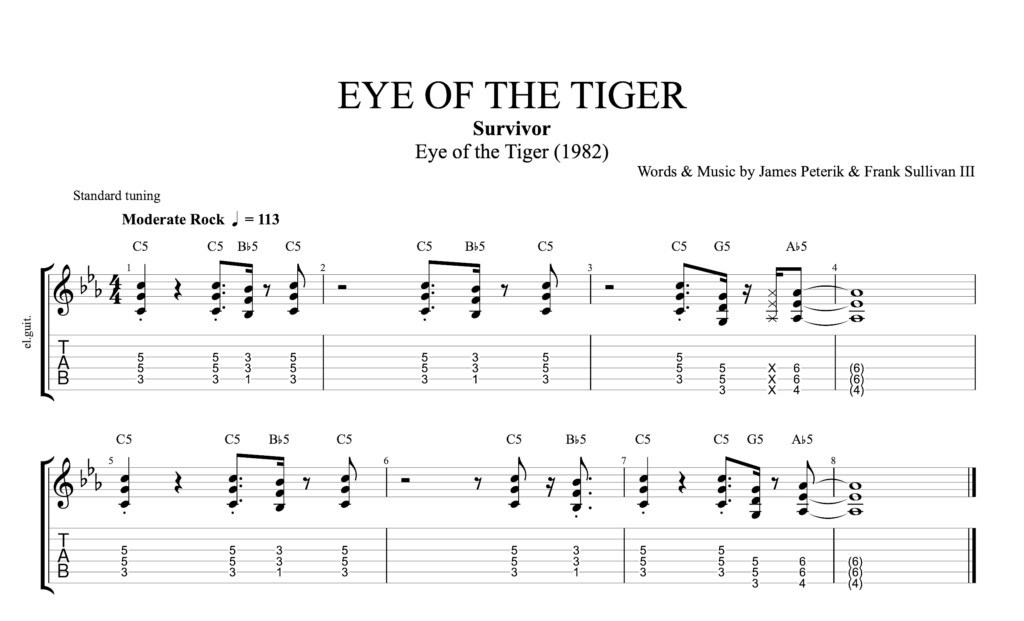 Eye of the tiger survivor intro tablature score guitar
Eye of the tiger survivor intro tablature score guitar
Download “Eye of the Tiger” Guitar Pro file
“Smells Like Teen Spirit” – Nirvana
“Smells Like Teen Spirit” is another iconic song that relies heavily on power chords. Its intro and verses are built around simple yet powerful chord changes.
Smells Like Teen Spirit – Nirvana – Intro
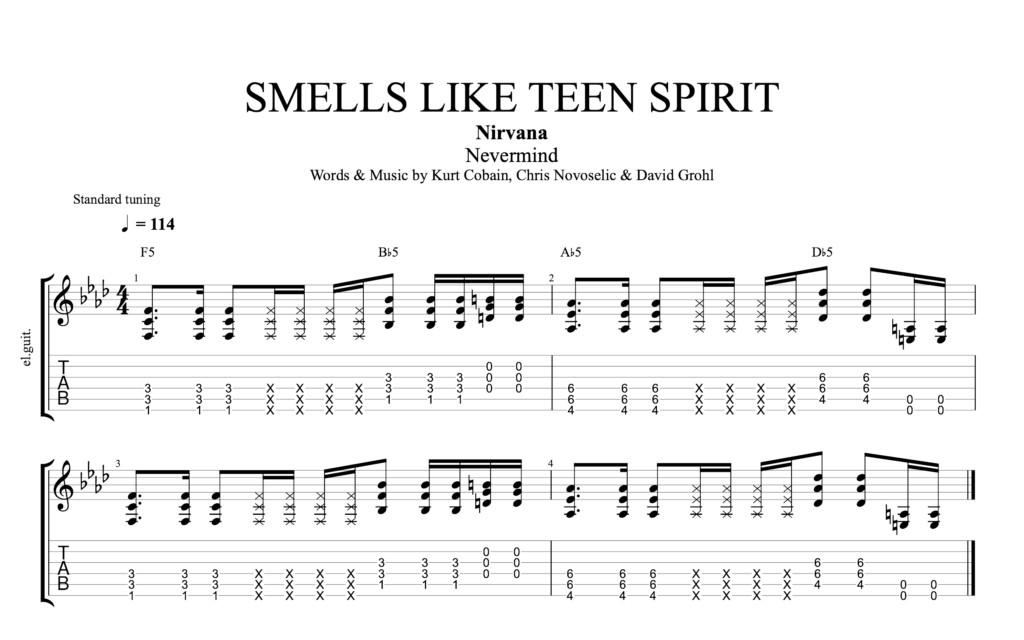 Nirvana 1991 Nevermind Smells_Like_Teen_Spirit Extract
Nirvana 1991 Nevermind Smells_Like_Teen_Spirit Extract
Download “Smells Like Teen Spirit” Guitar Pro file
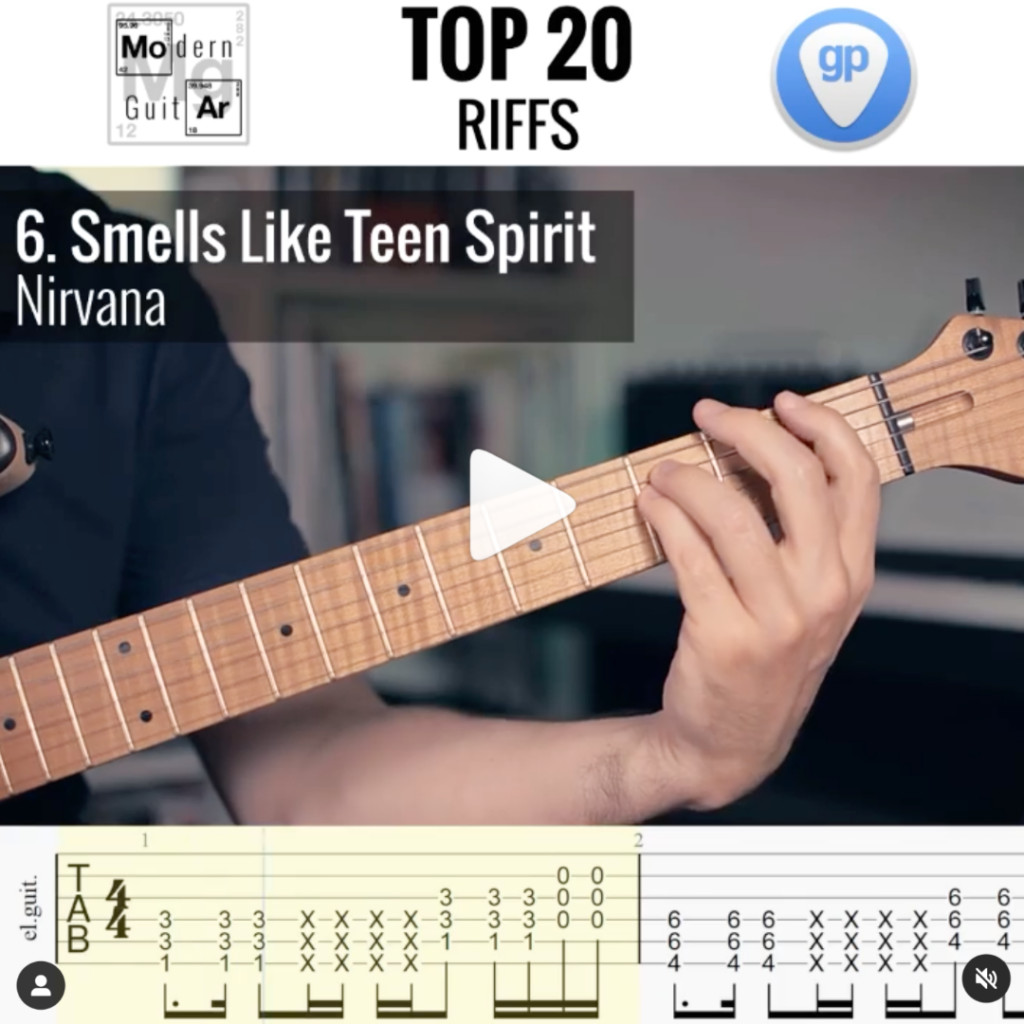 smell like teen spirit tablature instagram
smell like teen spirit tablature instagram
To enhance your practice, utilize software like Guitar Pro 7.5. This allows you to slow down song tempos, loop sections, and gradually increase speed as you improve. Explore mySongBook for a vast library of official Guitar Pro scores to learn complete songs.
When transitioning between power chords, try to keep your fretting fingers lightly touching the strings as you move to the next position. Release pressure only momentarily between chords to maintain fluidity.
Another valuable tool is the Play Guitar Hits app, which offers interactive guitar learning experiences.
Download the Power Chord Guide in PDF to keep all this information handy.
Conclusion
Power chords are a cornerstone of guitar playing, providing a powerful and accessible entry point into creating music. By understanding their construction, practicing the shapes, and applying them to songs you love, you’ll quickly integrate power chords into your playing. Mastering power chords not only expands your musical vocabulary but also builds essential guitar skills that will serve you well as you continue your guitar journey. So, pick up your guitar, start practicing, and unleash the power!

